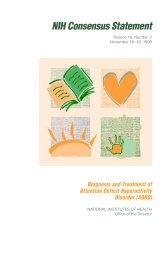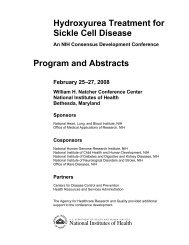Celiac Disease - NIH Consensus Development Program - National ...
Celiac Disease - NIH Consensus Development Program - National ...
Celiac Disease - NIH Consensus Development Program - National ...
You also want an ePaper? Increase the reach of your titles
YUMPU automatically turns print PDFs into web optimized ePapers that Google loves.
Worldwide, there is debate about the accepted definition for what constitutes“gluten-free.” Canadian standards state less than 20 ppm gluten, while other countries use200 ppm, and still others prefer a double standard for products rendered GF and those naturallyGF. This debate fuels confusion about labeling products GF. The current Codex Standard for“Gluten-Free Foods” was adopted by the Codex Alimentarius Commission in 1976 and amendedin 1983. In this document, gluten is defined as those proteins commonly found in wheat, triticale,rye, barley, or oats. The definition came under review in the1990s. As of the 25th Session of theCodex Alimentarius Commission, the definition of gluten-free continues to remain at Step 7while the committee awaits research on the scientific basis for the establishment of a tolerancelevel and a method of detection is clarified. (9,10) The Working Group on Prolamin Analysis andToxicity is currently evaluating a sandwich R5-ELISA system as proposed by the CodexAlimentarius Commission. This new system has good reproducibility (8.7 percent) andrepeatability (7.7 percent). In a study by Valdés et al., (11) the R5-ELISA was able to identifygliadins, hordeins, and secalins sensitivities of 0.78, 0.39 and 0.39 ng/ml, respectively. Theassay’s detection limit was 1.56 ppm gliadins, 3.2 ppm gluten. (12) Acceptance of R5-ELISA by theCodex Commission and results of ongoing research on tolerance levels will allow theCommission to advance towards a revised definition of gluten-free. The American DieteticAssociation (ADA), in conjunction with the Dietitians of Canada, revised the GFD guidelines in2000. These guidelines are based on the best available information at the time. Currently theADA is involved in a <strong>National</strong> Gluten-Free Diet Project to review these guidelines and provideevidence-based analysis. (13)Numerous studies document the impact of nutrient malabsorption caused from CD.Intestinal motor function caused by nutrient malabsorption may be partially responsible for thedelayed gastric emptying seen in children in a study by Perri et al. (14) Bona et al. shows lowdietary intake or malabsorption of B-vitamins, iron, and folic acid appear partially responsiblefor delayed puberty in children with CD. (15) Jameson (16) reports a correlation between zincdeficiencies and the severity of villous atrophy in adults. He also reports that the morepronounced the lesion, the lower the levels seen for iron, copper, folate, and vitamin B-12.Hallert et al. assessed the total plasma homocysteine levels in patients following a GFD.Compared to controls, persons following a GFD showed poorer vitamin status for folate, vitaminB-6, and vitamin B-12, even when taking nutrient supplements. (17) Studies report an incidence of4 percent anemia in the patients with newly diagnosed CD in the United States. While vitaminB-12 deficiency is not unusual in CD, pernicious anemia is considered uncommon. (18,19) Recoveryfrom iron-deficiency anemia is possible with GFD alone. (20) Bone disease in CD of adults andchildren is well documented in the literature. Calcium, vitamin D, magnesium, and fiber arealso limited in the GFD. In the United States, very few GF products are enriched, as arewheat-containing products, adding to the increased possibility of nutrient deficiencies. GFproducts, without enrichment, are lower in fiber, iron, folate, thiamin, riboflavin, and niacin. (12,21)Some patients report additional food sensitivities.In an Italian study of body composition and dietary intakes of adults with CD following astrict GFD, weight and body mass index of patients with CD was significantly lower than that ofcontrols, as was fat and lean body mass. Bone mineral content of women diagnosed as adults wassignificantly lower than controls. The diet of these patients was unbalanced and had a higherpercentage of calories from fat and less from carbohydrates. (22) A study by Mariani et al. showedsimilar results of the nutritional analysis of children with CD. They found the childrencomplying with a strict GFD had significantly greater nutrition imbalance in their diet than did92







